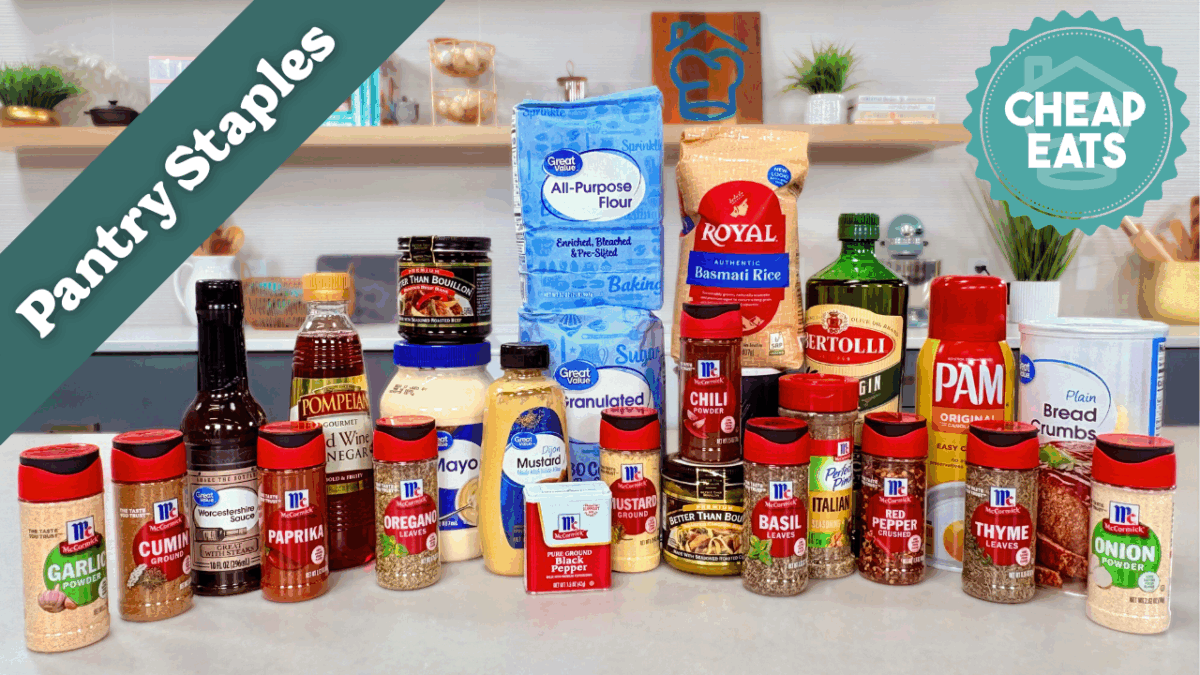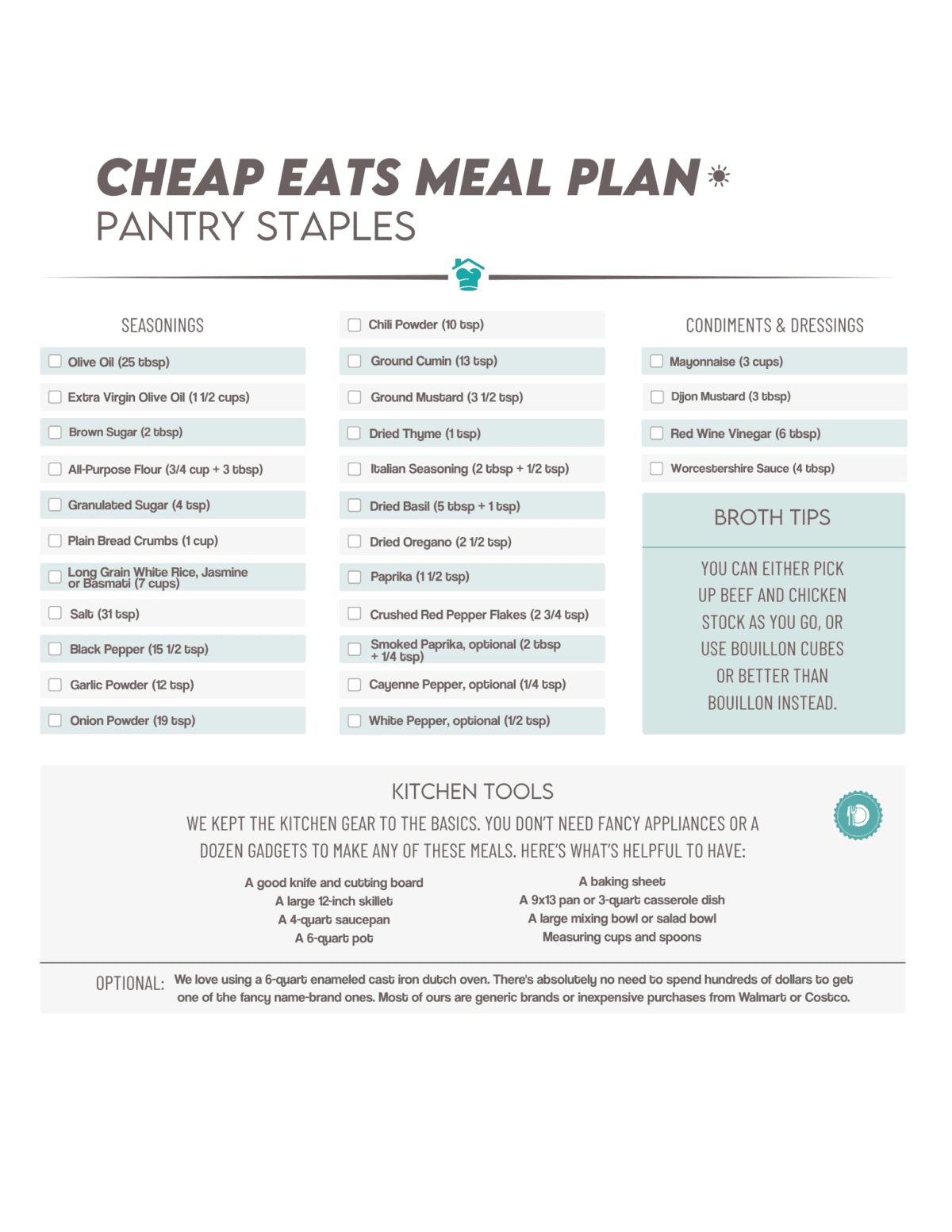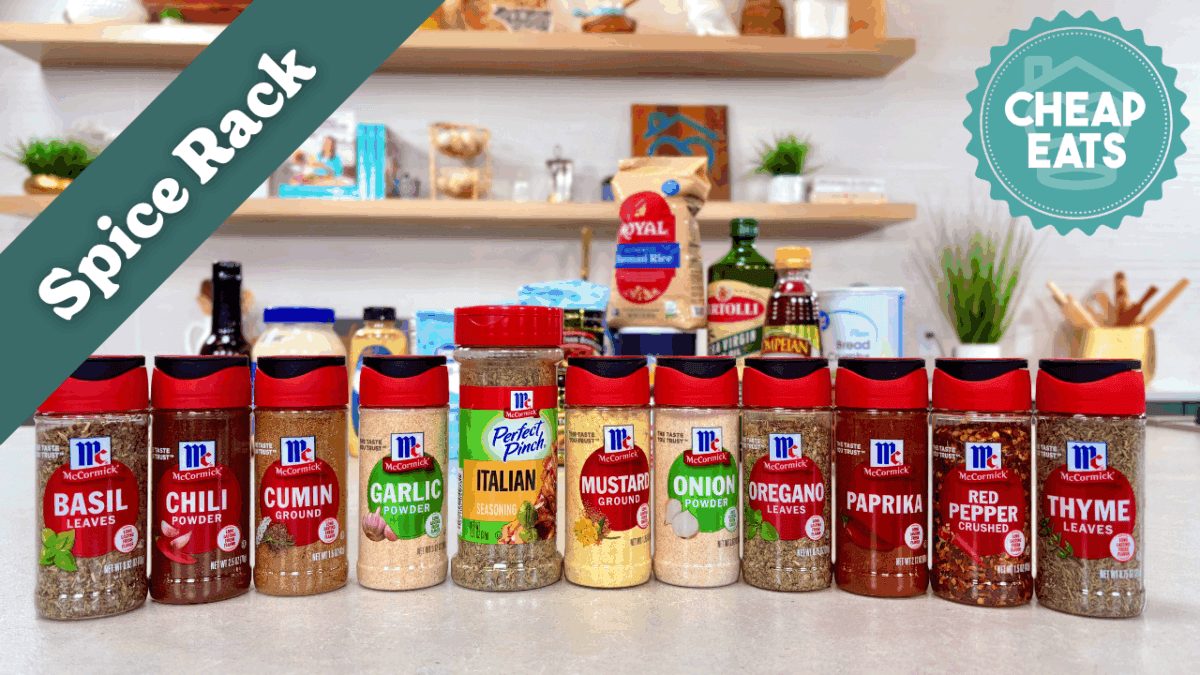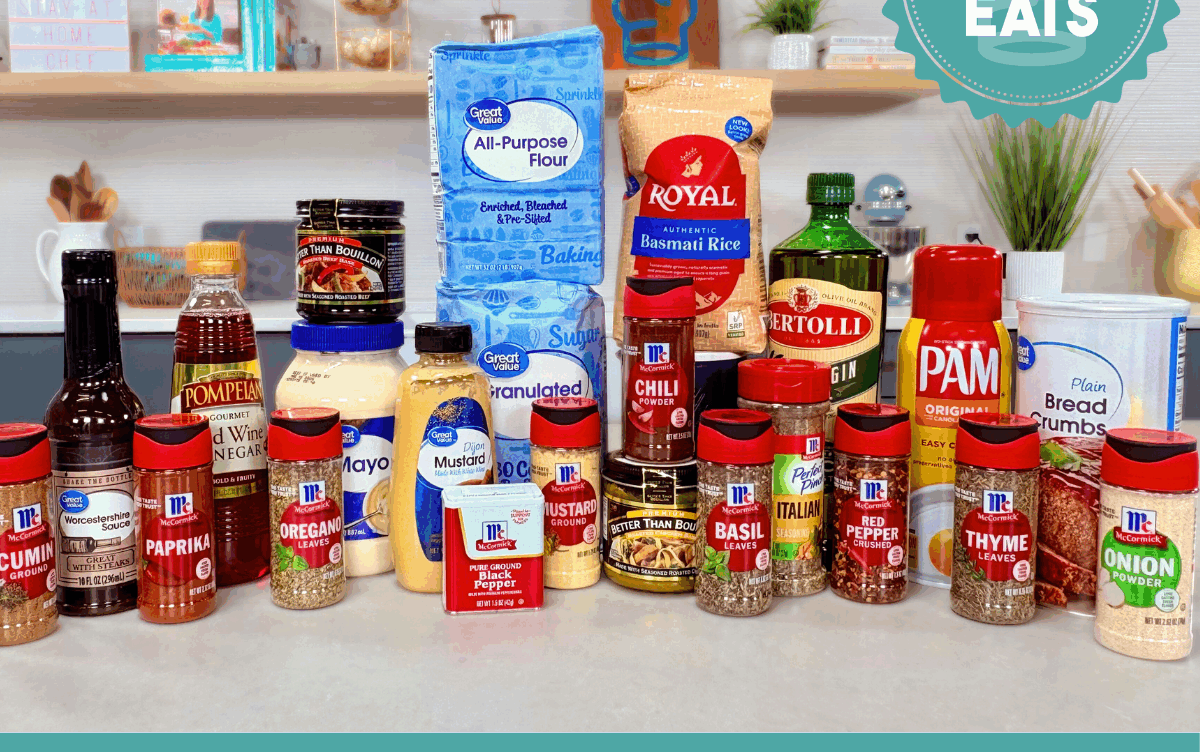Every good meal plan starts with a base set of pantry staples. Our goal was to have a limited base set to make sure they fit into any space, and don’t break the bank.

The List: Breakdown
Pantry Ingredients
- Extra Virgin Olive Oil: If you are only going to have one oil in your pantry, we recommend it’s extra virgin olive oil. Why? You can use it for both cooking and “finishing,” which is where you use the olive oil raw for things like dressings and marinades. If you want to save more money, you can buy two separate oils and use a cheaper oil, like vegetable or canola oil for cooking, and reserve the olive oil for finishing. Pro Tip: You can’t beat the price of the Costco bulk jug for extra virgin olive oil.
- Nonstick Cooking Spray: You need it so often, we’re including it in our list of pantry staples. A generic brand on this is totally fine.
- All-Purpose Flour: This is something you can buy as a generic brand. In cooking, it’s generally used as a thickening agent. You only need to keep a small amount on hand, and it lasts for 6 to 8 months in your pantry.
- Granulated Sugar: Grab a generic brand. The shelf life of sugar is basically indefinite. Just be sure to store it in an airtight container so nothing gets into it.
- Brown Sugar (optional): If you aren’t already using brown sugar in baking, then it’s not worth buying. Brown sugar is just granulated sugar mixed with a little molasses. It gives it a rich, darker flavor. It dries out and doesn’t keep for more than a month, so it’s wasteful to buy it for occasional use in cooking. If a recipe calls for brown sugar, you can just use the same amount of granulated sugar instead.
- Plain Bread Crumbs: Generic is totally fine to use for bread crumbs. We only use them in one recipe, but they have a shelf life of 1 year after opening so they won’t go to waste.
- Long Grain White Rice: Not all rice is the same! The least expensive bags labeled as “long grain white rice” usually contain lower-quality varieties that can cook up unevenly or turn out a little dry or sticky. Spending a little more on jasmine or basmati gives you better quality rice that cooks up consistently every time with better texture and flavor.



Spices, Herbs, and Seasonings
When it comes to purchasing spices, we strongly recommend getting a name-brand spice. It may seem counterintuitive for a meal plan focused on saving money, but there are good reasons. Name-brand spices consistently taste better and have a more concentrated flavor. It’s like you have to use double or triple the amount of a cheap, generic spice to get it to taste the same. Sometimes, the generic brands have a bitter flavor to them, or they just taste bland. Ground spices and dried herbs have a shelf life of 1 to 3 years, so it is worth it to make sure you have something quality to use over and over again.
- Salt
- Black Pepper
- Garlic Powder
- Onion Powder
- Chili Powder
- Ground Cumin
- Ground Mustard
- Dried Thyme
- Italian Seasoning
- Dried Basil
- Dried Oregano
- Paprika
- Crushed Red Pepper Flakes
Optional Spices
- Smoked Paprika (optional): You can use regular paprika in any recipe calling for smoked paprika, and you can use smoked paprika in any recipe calling for paprika. Just like the name says, the smoked variety adds a distinct smoky flavor. Some people love it, some people despise it, and everyone else falls somewhere in between. You don’t need it, but some people may want it.
- Cayenne Pepper (optional): This is just a way of adding a little heat to recipes. You can achieve the same thing with crushed red pepper flakes. Think of cayenne as a more finely ground version of crushed red pepper flakes so 1/2 teaspoon cayenne pepper is the equivalent of about 3/4 teaspoon of crushed red pepper flakes.
- White Pepper (optional): You really don’t need this one. It’s only used in our mac and cheese recipe. You can just use regular old black pepper. The only point of using white pepper is to hide the black specs. I guess we can just call this one a vanity ingredient since it’s all for looks.


Condiments/Fridge
- Mayonnaise: We did a taste test for this ingredient, and it turns out that generic brands across the board are the best option for a neutral flavor that you can use in any recipe.
- Dijon Mustard: We combined all of our regular mustard options into one that is the most versatile for flavor application across the recipes.
- Red Wine Vinegar: Like the mustard, we chose the vinegar that is best used for flavor application across the recipes. Feel free to buy any brand.
- Worcestershire Sauce: This is a condiment that packs a ton of flavor. Different brands do taste a little different. Feel free to just make a choice based on your budget and preferences.
Optional Condiments/Fridge
- Better Than Boullion (optional): A lot of our recipes use beef broth or chicken broth. This isn’t necessarily an endorsement of this specific brand, but it’s such a genius item. It’s a wet paste that you keep in your fridge. You mix small amounts of it with water, and you have broth. It tastes just as good as the boxed varieties, better than the canned, and way better than bouillon cubes, which can be quite salty. And it stays good in the fridge for 2 years!
- Hot Sauce (optional): We are suckers for hot sauce around here. None of the recipes actually call for it, but we’ll still add it to a bunch of them anyway. If you like heat, you may want to keep some hot sauce on hand to add a little spice to your life.

You are so kind and love all that you share! I have your cookbook and use quite a few recipes on the regular! I’m a nonnie to 2 grands with another on the way and so far they are loving your recipes! Thanks for your generosity, you have sn amazing gift and we are honored that you share it! God bless
Thank you so much for your support! I hope this meal plan helps.
You are just the sweetest thing! Always so kind. How generous of you to do this. I know it took a lot of work. And while most people would charge a lot for this, you give it away to others. I pray God will bless you abundantly for your kindness and sweet demeanor that you always convey. I know people are criticizing and mean, I’ve heard you mention comments over the years. I don’t know where that hate comes from when you are always so sweet! I just wanted to thank you so much for this as it will help me tremendously!
God bless,
Laura Cornman
Thank you so much for your kind words! This little corner of the internet has given me so much in my life. This meal plan is something I’m doing to give back and keep the internet the place I want and wish it could be. I hope it helps as many people as possible!
We made our first recipe and loved it! Thank
you for including us in the Cheap Eats Meal Plan pilot program!
Thank YOU for doing it! I’m loving hearing about your experiences!
Cannot wait to get started with you we are a family of 4 Adults
Sharyne
Enjoy! Please be sure to come back and let me know of any feedback you have so we can continue to improve on it.
I am looking forward to this.
So happy to hear this! Please let us know how it goes!
Please let us know how it goes when you start cooking! We’d love to hear any questions or comments you might have while making the recipes.
Thank you so much!! I couldn’t love this more – so helpful and such a time saver!!
I know I will love this!
Thank you for this recipes.
You’re welcome!
Does this come in printable pdf?
Yes it does! It’s available above.